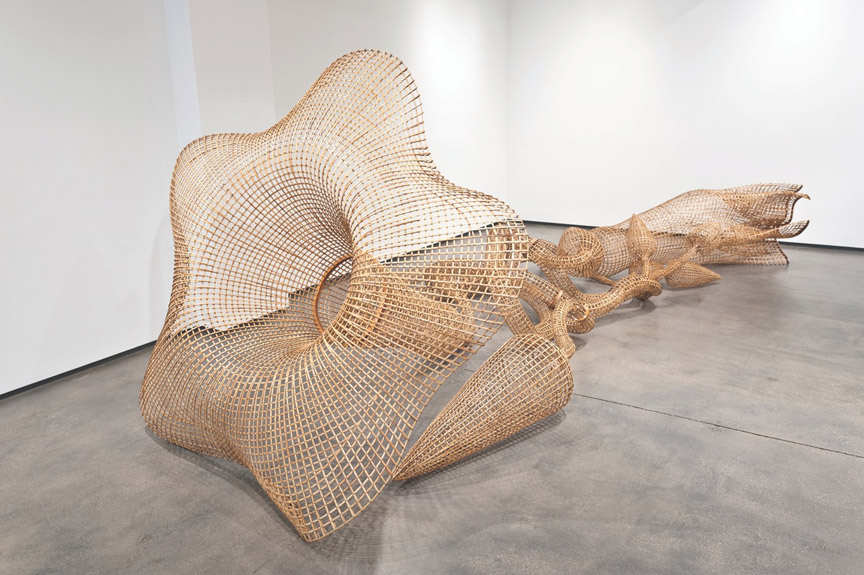Shows
Sopheap Pich’s “Morning Glory”


Sopheap Pich’s second solo exhibition in the United States at Tyler Rollins Fine Art has as its centerpiece a 5.3-meter-long sculpture of a morning glory plant with two large flowers and intertwined stems. The piece, entitled Morning Glory (2011), is one among several exhibited works created in the Cambodian-born, American-educated artist’s signature media of bamboo, rattan and burlap. Inspired by his childhood in Cambodia during the Khmer Rouge period (1975–79), Pich’s biomorphic sculptural and installations represent his response to the history and culture of his homeland.
With one flower closed and one in full bloom, Morning Glory was laid out on the floor in an entangled coil near the gallery entrance. The smooth curvature of the snake-like stems belies the work’s woven rattan-and-wire structure, attesting to Pich’s detailed craftsmanship. A common component of Cambodian cuisine, the artist remembers the morning glory as being a vital source of sustenance during the period of destitution brought upon by the Khmer Rouge. Along the walls of the gallery hung smaller versions of the work, Morning Glory 2 and Morning Glory 3 (both 2011), which snaked up diagonally like flowers in search of sunlight. Together, Pich’s renditions of this particular flower appear to be commemorative symbols of survival, family and people coming together during times of need.
At the opposite end of the gallery was Seated Buddha (2011), over 2.5-meters-tall, was a Buddha sitting cross-legged on the floor in the “lotus position,” made with rattan, bamboo, wire and plywood. Seated Buddha consists of a minimal outline, recognizable by its distinct head shape and iconic pose. Buddhism, the state religion of Cambodia for hundreds of years, was banned and virtually eradicated during the Khmer Rouge era, in which the Communist-inspired regime accused the religion of being reactionary and exploitative. With the fall of the Khmer Rouge, Buddhism was restored as the national religion, and is once again practiced by the majority of Cambodians today. Seated Buddha may then be a monument to or celebration of the Buddhist religion’s survival.
Moreover, the Buddha is believed by followers to be omnipresent and to manifest himself invisibly, such that one might sense his presence in everyday life without him being physically incarnate. Resonating with this idea, Pich’s sculpture is an abstract rendering of the deity, yet the Buddha’s presence in the work remains clearly recognizable.
Though addressing serious issues such as the travesties of the Khmer Rouge regime, Pich’s simple and elegant installations illustrate the artist’s triumphant reverence for the living customs and culture of his homeland.







